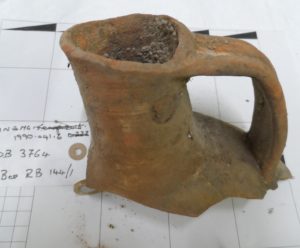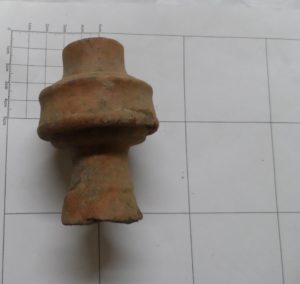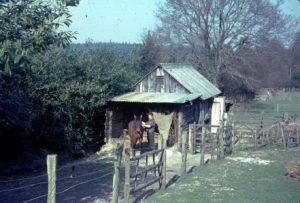Back to all posts
Barbara de Seyssell – an eye for archaeology at the shoreline

27th Mar 2020
By Samantha Harris
“She sells seashells on the seashore”, is not what Barbara de Seyssell did but something very similar, during the mid-nineteen fifties she walked the shore of the River Medway at Hoo St Werburgh.[1] collecting sherds (small pieces of broken pots) of Roman vessels uncovered by the water. Her collecting amassed almost enough base pieces to make 243 complete flagon type vessels which she kindly presented to the Maidstone Museum in 1956. The pottery was found on the islet scattered along the north beach and is presumed to have been eroded out of the shoreline over time. The area has changed quite a bit since Roman time. Despite the large quantity of pottery and the chance nature of the find, the collection is remarkably homogeneous, and includes a useful and typical series of most first-century flagon types. The Museum accession register suggests that there may have been a kiln site in the vicinity.
[1] Archaeologia Cantiana 70 1956 p. 273 – 277


Flagon neck and handle Collared flagon top
Looking through the many sherds made me wonder who the collector was. It proved difficult to discover much about her time in Kent. Ms de Seyssell was a Kent Archaeological Society member and took part in many digs including working on the Pivington moated manor site[1] near Pluckley She lived in Smarden before moving to the New Forest . In the 1960s she lived alone in a cottage at Holmhill where she engaged in woodland crafts and kept two horses. She was an animal lover and was dedicated to making sure the ponies roaming the forest were not killed or injured by traffic . The forest was then not gridded to keep the ponies and other animals safe and the A31 road was not yet fenced Apparently, she would round animals up and bring them back to the New Forest area when they strayed outside. . She successfully campaigned for gridding the forest and for the road to be fenced. When she died in the 1970s her home was demolished and returned to nature.[2] Ms de Seyssell was vocal in her support for projects close to her heart and was an active participant in public debate though her local newspaper.
[1] )Archaeologia Cantiana, 76 1962 p27
[2] Personal communication via email from Anthony Pasmore 11 February 2020

©Anthony Pasmore
The sherds are not amongst our ‘star finds’ but add to knowledge of Roman presence in the landscape of Hoo St Werburgh during the first century CE and it has been interesting discovering the personality who collected the objects for Women’s history month.
Mike Howard
Sources:
Archaeologia Cantiana vol 70, 1956, https://www.kentarchaeology.org.uk/sites/default/files/archcant/1957%2070%20Researches%20and%20Discoveries%20in%20Kent%201956_0.pdf
Archaeologia Cantiana, 76, 1962 p. 27
Museum Accession register entry MNEMG 1990.41
Mr Anthony Pasmore, personal communication via email 20 February 2020

